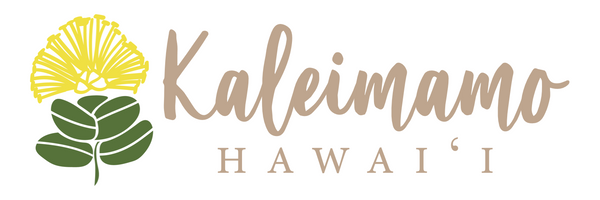Collection: Kapa Kuiki Lauaʻe
-
 Sold
Sold
out‘Eke Kōkua (Caddy)
Kapa Kuiki Lauaʻe
12 reviewsRegular price $48.00 USDRegular priceUnit price / per
About this print
Kapa Kuiki
Did you know that Hawaiian quilting was a part of Hawaiian culture before missionaries arrived in the islands? Hawaiian quilts were made from kapa, a type of fabric made from beating the bark of the wauke (paper mulberry) tree. Kapa was dyed and decorated with geometric block prints. When missionaries arrived in the islands around 1820, their wives brought woven fabrics and steel needles to teach the Hawaiian people how to create patchwork quilts. After learning the patchwork method from the missionary wives, Hawaiian women found it too colorful, busy, and difficult to see the stitches. This led to the development of the iconic Hawaiian quilt style that we see today. There are two types of Hawaiian quilting: Kapa Lau and Kapa ʻApana. The Kapa Lau style typically involves a central design in four to eight identical segments cut from one piece of fabric. The Kapa ʻApana style features a central medallion and a separately composed border.
It is said that the notorious ulu (breadfruit) pattern was the first Hawaiian quilt design. Legend has it that some women laid their fabric on the grass to dry and noticed the shadow of the ulu tree branches. They cut out this shadowy design, placed it onto another piece of fabric, and appliquéd it together. This inspired Hawaiian women to create unique quilts depicting the beauty of the islands, often drawing inspiration from their gardens and the land. Kākou Collective's collection of kapa kuiki designs does just that, featuring five plants beloved in Hawaiʻi. While most of these plants are introduced species, illustrator and founder of Kākou Collective, Kea Peters, chose to showcase them for their cultural significance in Hawaiʻi.
Pīkake, or Arabian Jasmine, is a delicate, white flower representing elegance and grace. With its beautiful appearance and sweet fragrance, pīkake is a very popular choice for lei making, especially for special occasions.
Pakalana, also known as the Chinese Violet, is often a symbol for unity and collaboration. With its small, clustered flowers and lovely scent, it is another favorite for lei making.
Pua kenikeni, the infamous “ten-cent flower,” represents transformation with its ability to change colors from white to yellow to orange. This beloved flower is often used in lei that we give to honor someone or celebrate significant life events. Its strong and sweet fragrance makes it an all time favorite throughout Hawaiʻi.
The well-known ʻōhiʻa lehua is said to represent resilience and new beginnings due to their ability to grow on new lava flows. The ʻōhiʻa lehua is deeply valued in Hawaiian culture and legends while playing a crucial role in Hawaiʻi’s native ecosystems.
The glossy fronds of the lauaʻe plant are more than mere foliage; they embody tales handed down through generations. Reflecting the verdant landscapes of the islands, the lauaʻe symbolizes freshness and purity in many Hawaiian legends.
These prints were added to our collection in partnership with Kea and her team at Kākou Collective.

